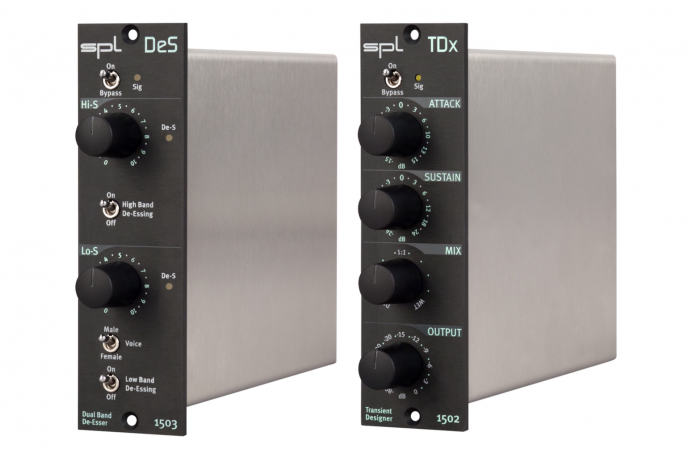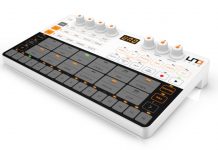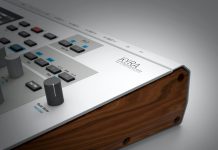The Transient Designer is one of the staples in any engineer who records drums. No other processor can handle dynamics in the way the Transient Designer can. Now you can rack up as many as you want with the 500 series model. On top of that SPL has released the reliable hardware de-esser in 500 series with the Model 1503 DeS.
NIEDERKRÜCHTEN, GERMANY: having made their formal introductions at The NAMM Show 2016, January 21-24 in Anaheim, California, USA, analogue and digital audio processor developer and manufacturer SPL is proud to announce that it is shipping its all-new Model 1503 DeS Dual Band De-Esser — the original Model 9629 Auto Dynamic de-Esser now available as a single-slot 500-Series module — and Model 1502 TDx Transient Designer — the original Model 9842 Transient Designer also available as a single-slot 500-Series module — as of February 17…
Back in 1996 SPL seriously made its intelligible mark on the professional music, film, multimedia, and broadcast industries by inventing the Model 9629 Auto Dynamic De-Esser, a revolutionary 19-inch, 1U signal processor that represented an alternative way to reduce sibilance based on phase cancellation. Unlike traditional compression techniques, this procedure is much more unobtrusive and simplifies controlling the processing intensity to a single (S-REDUCTION) parameter. Perhaps unsurprisingly, given its ease of use and easily-audible results, SPL’s Model 9629 Auto Dynamic De-Esser soon established itself as an industry-standard reference tool amongst discerning recording studios and broadcast stations, as well as the live sound engineering community.
Cleverly, in 2007 SPL successfully squeezed all this and more into its Model 1070 Dual Band De-Esser module for its proprietary RackPack modular system, allowing users to freely configure an analogue rack loaded with proven and new SPL processors. Pertaining to such space- saving requirements, the Model 1070 Dual Band De-Esser even expanded on SPL’s original concept by making use of two frequency bands — HIGH S-REDUCTION and LOW S-REDUCTION — that can be used independently or jointly to increase processing effectiveness without introducing any audible artefacts.
And now, with the proven popularity of the 500-Series so-called ‘Lunchbox’ modular rack frame format (and accompanying power supply) showing no signs of slowing down as an industry standard, this technology is also available as SPL’s all-new Model 1503 DeS Dual Band De- Esser 500-Series module, making it easier than ever for users to mix and match it with their favourite 500-Series modules. Moreover, such focused processing with high and low bands makes it possible to process sibilant sounds with greater precision than before. Indeed, input signals are automatically adjusted so that the processing is uniform, regardless of the distance between source and microphone. Better still, switchable Male/Female Voice modes adapt processing in the lower band to better suit male or female voices.
Stepping briefly back in time again, in 1998 SPL showcased another audio breakthrough by inventing its Differential Envelope Technology (DET), which allows for level-independent dynamic processing by calculating differences in generated envelopes. These envelopes are always tracking the curve of the original signal to provide optimal results in every musical moment. The first product to make use of this technological breakthrough was SPL’s Model 9842 Transient Designer. Like the Model 9629 Auto Dynamic De-Esser before it, the 19-inch, 1U Model 9842 Transient Designer is surprisingly simple in use — using the ATTACK controls, attacks can be amplified or attenuated and, using the SUSTAIN controls, sustains can be lengthened or shortened. Only two such controls per channel are required to allow the user to totally reshape the attack and sustain characteristics of any sound. Simple. Saying that, the possibilities for studio and live applications are almost endless. And, again, SPL’s space-saving savvy saw this technology also making its musical way into its proprietary RackPack modular system in 2007 as the Model 2715 Transient Designer module, complete with an added OUTPUT GAIN control.
Today, though, all this and more is also available in the wonderful world of 500-Series rack modules as the Model 1502 TDx Transient Designer. Thanks to the new MIX (parallel mix) control, users can continuously blend between the processed (WET) and unprocessed (DRY) signal, so functionality is extended further still with three parameters — ATTACK, SUSTAIN, and MIX, each offering intuitive operation while combining to increase options for designing transients to suit a greater variety of programme material.
Audio specifications for the Model 1503 DeS Dual Band De-Esser and Model 1502 TDx Transient Designer are second to none, both benefitting from an impressive 10 Hz to 100 kHz frequency response and 116 dB dynamic range. So why not let SPL boost the musical range of your 500-Series module collection by racking up one or more Model 1503 DeS Dual Band De-Esser and Model 1502 TDx Transient Designer modules!
For more in-depth information, please visit the dedicated Model 1503 DeS Dual Band De-Esser product webpage here:
http://spl.info/en/products/3338/des/overview.html
For more in-depth information, please visit the dedicated Model 1502 TDx Transient Designer product webpage here:
http://spl.info/en/products/3338/tdx/overview.html














